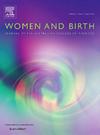The social conception of space of birth according to women with positive birth experiences: A trans-European study
IF 4.4
2区 医学
Q1 NURSING
引用次数: 0
Abstract
Background
The social space of birth—the birth environment, its occupants, and the human activities taking place—is interconnected with birth experiences.
Aim
To investigate how the reality of the social space of birth affects women’s positive birth experiences.
Methods
We combined open-text responses to the Babies Born Better survey from 3633 postpartum women in Austria, Belgium, the Czech Republic, Germany, Spain, the Netherlands, and the United Kingdom and 39 interview transcripts from Czech and Dutch postpartum women. We conducted a textual and thematic analysis.
Findings
Three themes and 11 categories were generated: (1) Exercising fundamental human agency in the birth space consists of the categories: ‘exercising rights’, ‘the protection of human vulnerability’, and ‘the freedom to be authentic’, which women regard as prerequisite components of the birth space. (2) Regulatory frameworks & care philosophies in maternity services, including the categories ‘(financial) regulations’, ‘values of the care provider and the institution’, and ‘model of care’, are regarded as attributes of the birth space. Theme (3) Building a nest for comfort and connection comprises the categories ‘relational and affective atmosphere during labour & birth’, ‘performative atmosphere during labour & birth’, ‘shelter’, ‘implicit and explicit tacit doing & being’ and ‘symbol of deeper meaning’.
Discussion/Conclusion
The reality of the birth space of women with positive birth experiences consists of human rights and birth rights, the quality of interactions with care providers during labour and birth in a relationship-centred and relation-continuity model of care, and a place to retreat from the world.
积极生育经验妇女生育空间的社会观念:一项跨欧洲的研究
出生的社会空间——出生环境、居住者和发生的人类活动——与出生体验是相互联系的。目的探讨生育社会空间的现实性如何影响女性积极的生育体验。方法我们将来自奥地利、比利时、捷克共和国、德国、西班牙、荷兰和英国的3633名产后妇女对“婴儿出生更好”调查的开放文本回复和来自捷克和荷兰产后妇女的39份访谈记录结合起来。我们进行了文本和主题分析。(1)在生育空间中行使基本的人类能动性包括“行使权利”、“保护人类的脆弱性”和“保持真实的自由”三个类别,女性认为这三个类别是生育空间的先决条件。(2)监管框架&;产妇服务中的护理理念,包括“(财务)条例”、“护理提供者和机构的价值”和“护理模式”等类别,被视为分娩空间的属性。主题(3)营造一个舒适和连接的巢,包括劳动和生活中的关系和情感氛围;《出生》、《劳动时的表演气氛》;“出生”,“庇护”,“隐性和显性的隐性行为& &;“存在”和“深层意义的象征”。讨论/结论具有积极生育经历的妇女的生育空间的现实包括人权和生育权利,在以关系为中心和关系连续性的护理模式下,在分娩和分娩期间与护理提供者的互动质量,以及一个远离世界的地方。
本文章由计算机程序翻译,如有差异,请以英文原文为准。
求助全文
约1分钟内获得全文
求助全文
来源期刊

Women and Birth
NURSING-OBSTETRICS & GYNECOLOGY
CiteScore
7.20
自引率
13.20%
发文量
371
审稿时长
27 days
期刊介绍:
Women and Birth is the official journal of the Australian College of Midwives (ACM). It is a midwifery journal that publishes on all matters that affect women and birth, from pre-conceptual counselling, through pregnancy, birth, and the first six weeks postnatal. All papers accepted will draw from and contribute to the relevant contemporary research, policy and/or theoretical literature. We seek research papers, quality assurances papers (with ethical approval) discussion papers, clinical practice papers, case studies and original literature reviews.
Our women-centred focus is inclusive of the family, fetus and newborn, both well and sick, and covers both healthy and complex pregnancies and births. The journal seeks papers that take a woman-centred focus on maternity services, epidemiology, primary health care, reproductive psycho/physiology, midwifery practice, theory, research, education, management and leadership. We also seek relevant papers on maternal mental health and neonatal well-being, natural and complementary therapies, local, national and international policy, management, politics, economics and societal and cultural issues as they affect childbearing women and their families. Topics may include, where appropriate, neonatal care, child and family health, women’s health, related to pregnancy, birth and the postpartum, including lactation. Interprofessional papers relevant to midwifery are welcome. Articles are double blind peer-reviewed, primarily by experts in the field of the submitted work.
 求助内容:
求助内容: 应助结果提醒方式:
应助结果提醒方式:


